聊聊Vue3+hook怎麼寫彈窗元件更快更高效

為什麼會有這個想法
在管理後臺開發過程中,涉及到太多的彈窗業務彈窗,其中最多的就是「新增XX資料」,「編輯XX資料」,「檢視XX詳情資料」等彈窗型別最多。【相關推薦:、】
這些彈窗元件的程式碼,很多都是相同的,例如元件狀態,表單元件相關的方法...
於是,我簡單地對Dialog元件進行的二次封裝和hooks,減少了一些重複的程式碼
要封裝什麼
如果是普通彈窗使用的話,直接使用el-dialog元件已經足夠了
但我還是一個比較愛折騰的人,我們先看看官方dialog檔案有什麼可以新增的功能
...
大概看了一下,我打算封裝一下功能
- 提供全螢幕操作按鈕(右上角)
- 預設提供「確認」,「關閉」按鈕
- 內部新增
Loading效果
封裝Dialog
確定了要封裝的功能之後,先來一個簡單的dialog元件。
把雙向繫結處理一下,這樣外部就可以直接通過v-model直接控制彈窗了。
<template>
<el-dialog :model-value="props.modelValue"></el-dialog>
</template>
<script setup>
interface PropsType {
modelValue?: boolean;
}
const props = withDefaults(defineProps<PropsType>(), {
modelValue: false,
});
const emits = defineEmits<{
(e: "update:modelValue"): void;
}>();
</script>登入後複製header
這裡使用到圖示庫@element-plus/icons-vue
如沒有安裝,請執行npm install @element-plus/icons-vue
使用el-dialog提供的header插槽,將全螢幕圖表和關閉圖示放置到右上角中。給el-dialog傳遞show-close屬性關閉預設圖示。
<template>
<el-dialog :model-value="props.modelValue" :show-close="false">
<template #header>
<div>
<span>{{ props.title }}</span>
</div>
<div>
<el-icon><FullScreen /></el-icon>
<el-icon><Close /></el-icon>
</div>
</template>
</el-dialog>
</template>
<script setup>
import { FullScreen, Close } from "@element-plus/icons-vue";
</script>
<style scoped>
// 處理樣式
:deep(.el-dialog__header) {
border-bottom: 1px solid #eee;
display: flex;
padding: 12px 16px;
align-items: center;
justify-content: space-between;
margin: 0;
}
.dialog-title {
line-height: 24px;
font-size: 18px;
color: #303133;
}
.btns {
display: flex;
align-items: center;
i {
margin-right: 8px;
font-size: 16px;
cursor: pointer;
}
i:last-child {
margin-right: 0;
}
}
</style>登入後複製彈窗的標題文字內容通過props進行傳遞,預設為空('')
<script lang="ts" setup>
interface PropsType {
// 忽略之前的程式碼
title?: string;
}
const props = withDefaults(defineProps<PropsType>(), {
title: "",
});
</script>登入後複製我們看看現在頭部的效果(這裡沒傳入標題,預設為'')
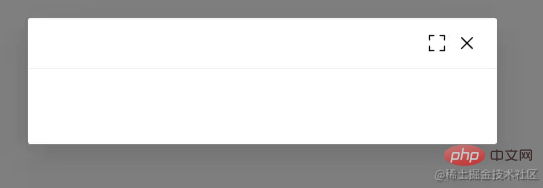
現在這個按鈕只有樣式效果,還沒有寫上對應的功能 ~
給他們先繫結上對應的事件和指令
<template>
<el-dialog
:model-value="props.modelValue"
:show-close="false"
:fullscreen="attrs?.fullscreen ?? isFullscreen"
>
<template #header>
<div>
<span class="dialog-title">{{ props.title }}</span>
</div>
<div class="btns">
<el-icon v-if="isFullScreenBtn" @click="handleFullscreen"
><FullScreen
/></el-icon>
<el-icon @click="handleClose"><Close /></el-icon>
</div>
</template>
</el-dialog>
</template>
<script setup lang="ts">
import { FullScreen, Close } from "@element-plus/icons-vue";
interface PropsType {
title?: string;
modelValue?: boolean;
hiddenFullBtn?: boolean;
}
const props = withDefaults(defineProps<PropsType>(), {
title: "",
modelValue: false,
hiddenFullBtn: false,
});
const emits = defineEmits<{
(e: "update:modelValue"): void;
(e: "close"): void;
}>();
// 當前是否處於全螢幕狀態
const isFullscreen = ref(false);
// 是否顯示全螢幕效果圖示
const isFullScreenBtn = computed(() => {
if (props.hiddenFullBtn) return false;
if (attrs?.fullscreen) return false;
return true;
});
// 開啟、關閉全螢幕效果
const handleFullscreen = () => {
if (attrs?.fullscreen) return;
isFullscreen.value = !isFullscreen.value;
};
// 關閉彈窗時向外部傳送close事件
const handleClose = () => {
emits("close");
};
</script>登入後複製再點選下全螢幕圖示看看效果怎麼樣
NICE 頭部功能也就完成了
Footer
接下來,再處理下底部內容,預設提供兩個按鈕,分別是「確定」和「關閉」,這個名稱也是可以通過props屬性修改的。
兩個按鈕繫結點選事件,向外傳送不同的事件。
<template>
<div class="">
<el-dialog
v-bind="attrs"
:model-value="props.modelValue"
:show-close="false"
:fullscreen="attrs?.fullscreen ?? isFullscreen"
>
<template #footer>
<!-- 如果沒有提供其他footer插槽,就使用預設的 -->
<span v-if="!slots.footer" class="dialog-footer">
<el-button type="primary" @click="handleConfirm">{{
props.confirmText
}}</el-button>
<el-button @click="handleClose">{{ props.cancelText }}</el-button>
</span>
<!-- 使用傳入進來的插槽 -->
<slot v-else name="footer"></slot>
</template>
</el-dialog>
</div>
</template>
<script setup lang="ts">
import { useSlots } from "vue";
// 獲取插槽
const slots = useSlots();
interface PropsType {
title?: string;
width?: string | number;
isDraggable?: boolean;
modelValue?: boolean;
hiddenFullBtn?: boolean;
confirmText?: string;
cancelText?: string;
}
const props = withDefaults(defineProps<PropsType>(), {
title: "",
isDraggable: false,
modelValue: false,
hiddenFullBtn: false,
confirmText: "確認",
cancelText: "關閉",
});
const handleClose = () => {
emits("close");
};
const handleConfirm = () => {
emits("confirm");
};
</script>登入後複製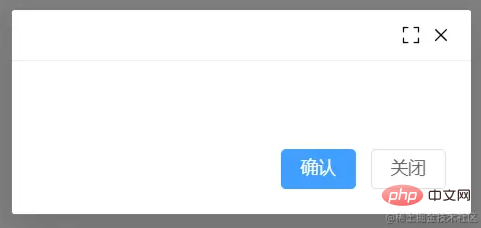
又搞定了一部分了,就剩下Content了 ~
Content
彈窗內容通過預設插槽的方式傳入進來,在外層的div元素上新增v-loading標籤,實現載入態。
如果你想整個彈窗實現loading效果,請把v-loading移到最外層元素即可。 注意不能是el-dialog元素上,否則無法實現 可能是el-dialog使用了teleport元件,導致v-loading無法正常工作。 等有空研究一下 ~
<template>
<div class="">
<el-dialog
v-bind="attrs"
:model-value="props.modelValue"
:show-close="false"
:fullscreen="attrs?.fullscreen ?? isFullscreen"
>
<div class="content" v-loading="props.loading">
<slot></slot>
</div>
</el-dialog>
</div>
</template>
<script lang="ts" setup>
interface PropsType {
loading?: boolean;
}
const props = withDefaults(defineProps<PropsType>(), {
loading: false,
});
</script>登入後複製試試看中間的loading效果
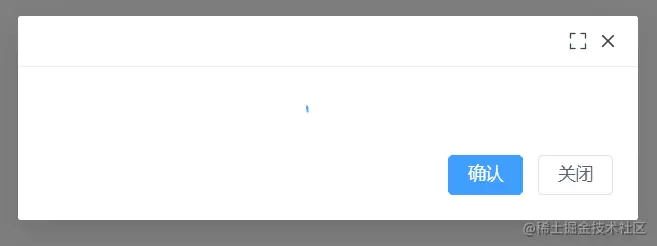
剩下一些細節處理
在el-dialog元件提供了很多個props屬性供使用者選擇,但我們現在封裝的dialog元件只使用到了一小部分props屬性。當使用者想要使用其他的props屬性時該怎麼辦?
例如使用width屬性時,難道要在我們封裝的元件中接收props.width再傳遞給<el-dialog :width="props.width" />元件嗎?
不不不,還有另外一種方法,還記得剛剛在做全螢幕操作的時候使用到的useAttrs輔助函數嗎
它可以獲取當前元件傳遞進來的屬性。有了這個方法之後,再配合並即可將外部傳遞進來的函數再傳遞到el-dialog元件上面啦
<el-dialog
v-bind="attrs"
:model-value="props.modelValue"
:show-close="false"
:fullscreen="attrs?.fullscreen ?? isFullscreen"
:before-close="handleClose"
>
<!-- 忽略其他程式碼 -->
</el-dialog>登入後複製為了避免內部傳遞的props被覆蓋掉,
v-bind="attrs"需要放在最前面
在使用時,可能會給before-close屬性傳遞一個函數,但到了後面被內部的handleClose方法給覆蓋掉了。
解決方案是在handleClose函數中,獲取attrs.['before-close']屬性,如果型別是函數函數,先執行它。
const handleClose = () => {
if (
Reflect.has(attrs, "before-close") &&
typeof attrs["before-close"] === "function"
) {
attrs["before-close"]();
}
emits("close");
};登入後複製有關於el-dialog元件的封裝就到這裡了
封裝hooks
利用Vue composition Api再封裝一下在使用el-dialog元件狀態的管理hook
useDialog
簡單處理顯示和載入態開關的hook
import { ref } from "vue";
export default function useDialog() {
const visible = ref(false);
const loading = ref(false);
const openDialog = () => (visible.value = true);
const closeDialog = () => (visible.value = false);
const openLoading = () => (loading.value = true);
const closeLoading = () => (loading.value = false);
return {
visible,
loading,
openDialog,
closeDialog,
openLoading,
closeLoading,
};
}登入後複製useDialog Demo
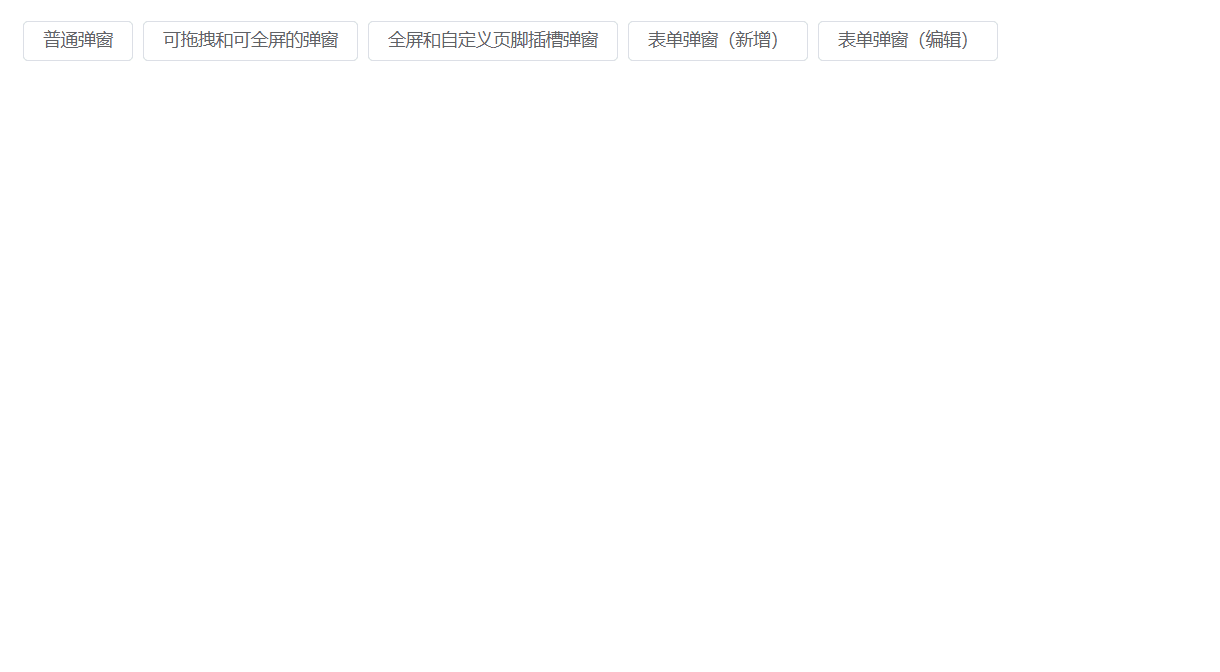
<template>
<el-button @click="openDialog1">普通彈窗</el-button>
<DialogCmp
title="DialogCmp1"
:hiddenFullBtn="true"
v-model="visible1"
@confirm="handleConfirm"
@close="handleClose"
>
<h3>DialogCmp1</h3>
</DialogCmp>
</template>
<script setup lang="ts">
import useDialog from "./components/useDialog";
import DialogCmp from "./components/Dialog.vue";
const {
visible: visible1,
openDialog: openDialog1,
closeDialog: closeDialog1,
} = useDialog();
</script>登入後複製useDialogState 和 useDialogWithForm
useDialogState
針對開發管理後臺彈窗狀態封裝的一個hook,搭配下面的useDialogWithForm使用。
export enum MODE {
ADD, EDIT,
}登入後複製import { ref } from "vue";
import { MODE } from "./types";
export default function useDialogState() {
const mode = ref<MODE>(MODE.ADD);
const visible = ref(false);
const updateMode = (target: MODE) => {
mode.value = target;
};
return { mode, visible, updateMode };
}登入後複製useDialogWithForm
針對表單彈窗元件封裝的hooks,接收一個formRef範例,負責控制彈窗內標題及清空表單中的校驗結果,減少多餘的程式碼 ~
import { FormInstance } from "element-plus";
import { Ref, ref } from "vue";
import { MODE } from "./types";
import useDialogState from "./useDialogState";
export default function useDialogFn(
formInstance: Ref<FormInstance>
) {
const { visible, mode, updateMode } = useDialogState();
const closeDialog = () => {
formInstance.value.resetFields();
visible.value = false;
};
const openDialog = (target: MODE) => {
updateMode(target);
visible.value = true;
};
return { visible, mode, openDialog, closeDialog };
}登入後複製useDialogWithForm Demo
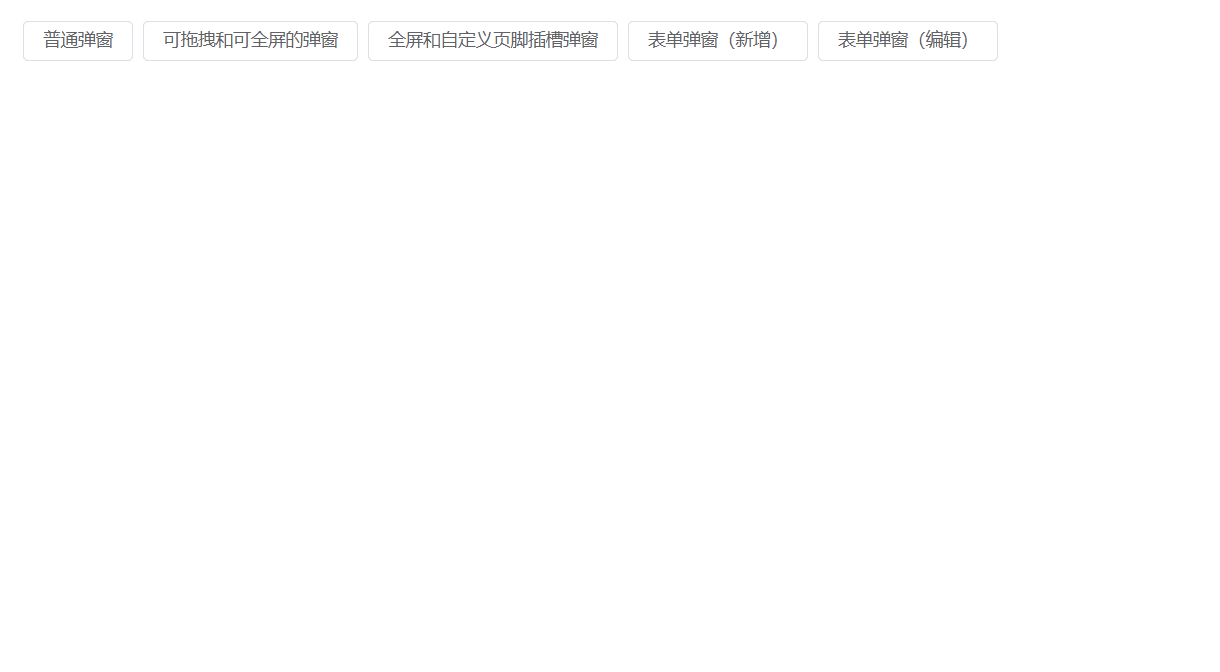
<template>
<Dialog
:before-close="customClose"
@confirm="confirm"
v-model="visible"
:title="mode == MODE.ADD ? '新增資料' : '編輯資訊'"
:confirm-text="mode == MODE.ADD ? '新增' : '修改'"
>
<el-form
label-width="100px"
:model="formData"
ref="formDataRef"
style="max-width: 460px"
:rules="rules"
>
<el-form-item label="姓名" prop="name">
<el-input v-model="formData.name" />
</el-form-item>
<el-form-item label="年齡" prop="age">
<el-input v-model="formData.age" />
</el-form-item>
<el-form-item label="手機號碼" prop="mobile">
<el-input v-model="formData.mobile" />
</el-form-item>
</el-form>
</Dialog>
</template>
<script setup>
import { ElMessage, FormInstance } from "element-plus";
import { Ref, ref } from "vue";
import Dialog from "./Dialog.vue";
import { MODE } from "./types";
import useDialogWithForm from "./useDialogWithForm";
const rules = {
name: {
type: "string",
required: true,
pattern: /^[a-z]+$/,
trigger: "change",
message: "只能是英文名稱哦",
transform(value: string) {
return value.trim();
},
},
age: {
type: "string",
required: true,
pattern: /^[0-9]+$/,
trigger: "change",
message: "年齡只能是數位哦",
transform(value: string) {
return value.trim();
},
},
mobile: {
type: "string",
required: true,
pattern:
/^(?:(?:\+|00)86)?1(?:(?:3[\d])|(?:4[5-79])|(?:5[0-35-9])|(?:6[5-7])|(?:7[0-8])|(?:8[\d])|(?:9[189]))\d{8}$/,
trigger: "change",
message: "請輸入正確的手機號碼",
transform(value: string) {
return value.trim();
},
},
};
interface FromDataType {
name: string;
age: string;
mobile: string;
}
const formDataRef = ref<FormInstance | null>(null);
let formData = ref<FromDataType>({
name: "",
age: "",
mobile: "",
});
const { visible, closeDialog, openDialog, mode } = useDialogWithForm(
formDataRef as Ref<FormInstance>
);
const confirm = () => {
if (!formDataRef.value) return;
formDataRef.value.validate((valid) => {
if (valid) {
console.log("confirm");
ElMessage({
message: "提交成功",
type: "success",
});
closeDialog();
}
});
};
const customClose = () => {
ElMessage({
message: "取消提交",
type: "info",
});
closeDialog();
};
defineExpose({
closeDialog,
openDialog,
});
</script>
<style scoped></style>登入後複製倉庫地址
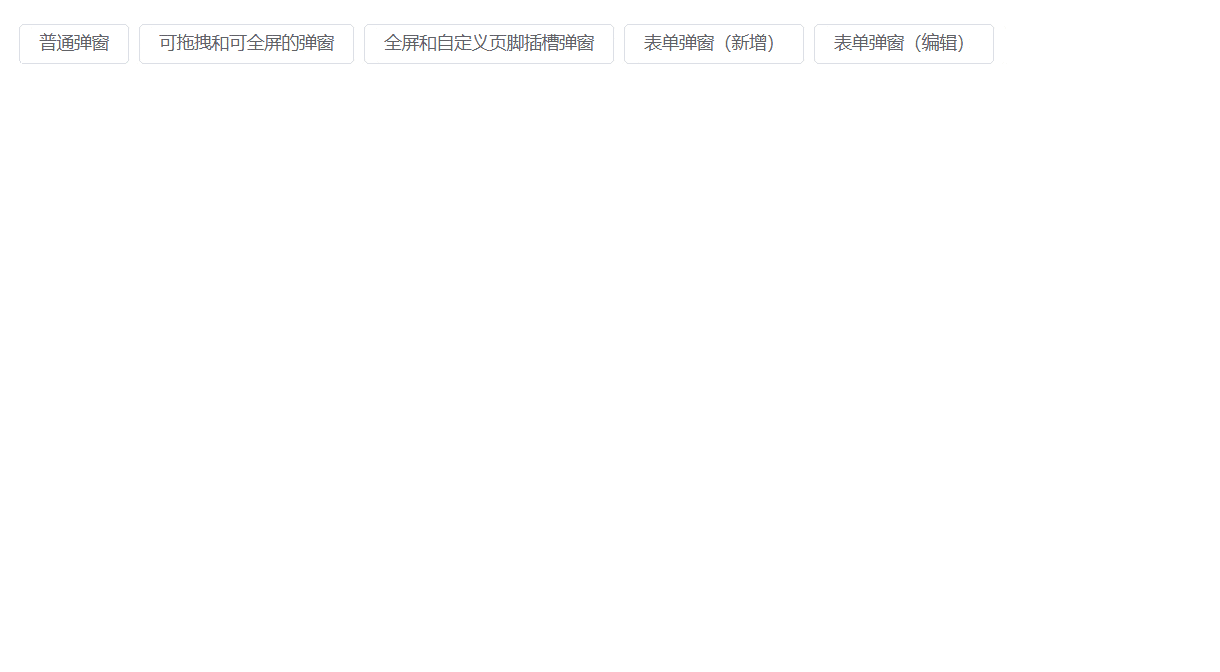
如果您覺得本文對您有幫助,請幫幫忙點個star
您的反饋 是我更新的動力!
(學習視訊分享:、)
以上就是聊聊Vue3+hook怎麼寫彈窗元件更快更高效的詳細內容,更多請關注TW511.COM其它相關文章!